 W
WA color code or colour code is a system for displaying information by using different colors.
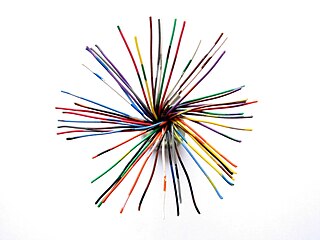 W
WThe 25-pair color code, originally known as even-count color code, is a color code used to identify individual conductors in twisted-pair wiring for telecommunications.
 W
WThe Broselow Tape, also called the Broselow pediatric emergency tape, is a color-coded length-based tape measure that is used throughout the world for pediatric emergencies. The Broselow Tape relates a child's height as measured by the tape to his/her weight to provide medical instructions including medication dosages, the size of the equipment that should be used, and the level of shock voltage when using a defibrillator. Particular to children is the need to calculate all these therapies for each child individually. In an emergency the time required to do this detracts from valuable time needed to evaluate, initiate, and monitor patient treatment. The Broselow Tape is designed for children up to approximately 12 years of age who have a maximum weight of roughly 36 kg. The Broselow Tape is recognized in most medical textbooks and publications as a standard for the emergency treatment of children.
 W
WData visualization achieves its significance today due to information technology: big data processed in computers with capable visualization software, combined with statistical techniques and color coding on electronic displays. This article is about color coding technology for data visualization.
 W
WIn chemistry, the CPK coloring is a popular color convention for distinguishing atoms of different chemical elements in molecular models.
 W
WElectrical wiring is an electrical installation of cabling and associated devices such as switches, distribution boards, sockets, and light fittings in a structure.
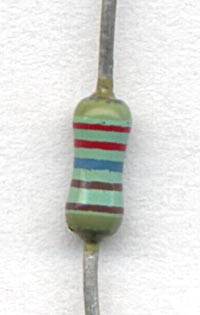 W
WAn electronic color code is used to indicate the values or ratings of electronic components, usually for resistors, but also for capacitors, inductors, diodes and others. A separate code, the 25-pair color code, is used to identify wires in some telecommunications cables. Different codes are used for wire leads on devices such as transformers or in building wiring.
 W
WMnemonics are used to help memorize the electronic color codes for resistors. Mnemonics describing specific and relatable scenarios are more memorable than abstract phrases.
 W
WHANDEL was the code-name for the UK's national attack warning system in the Cold War. It consisted of a small console with two microphones, lights and gauges. The reason behind this was to provide a back-up if anything failed.
 W
WThe handkerchief code is a system of color-coded cloth handkerchief or bandanas for non-verbally communicating one's interests in sexual activities and fetishes. The color of the handkerchief identifies a particular activity, and the pocket it is worn in identifies the wearer's preferred role in that activity. Wearing a handkerchief on the left side of the body typically indicates one is a "top", while wearing it on the right side of the body would indicate one is a "bottom". For example, a dark blue handkerchief indicates an interest in anal sex, and wearing it in the left pocket indicates a preference for being the insertive partner. The code was most widely used in the 1970s in the United States, Canada, Australia, and Europe, by gay and bisexual men seeking casual sex, or BDSM practitioners.
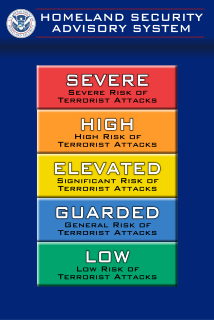 W
WIn the United States, the Homeland Security Advisory System was a color-coded terrorism threat advisory scale. The different levels triggered specific actions by federal agencies and state and local governments, and they affected the level of security at some airports and other public facilities. It was often called the "terror alert level" by the U.S. media. The system was replaced on April 27, 2011, with a new system called the National Terrorism Advisory System.
 W
WLiturgical colours are specific colours used for vestments and hangings within the context of Christian liturgy. The symbolism of violet, white, green, red, gold, black, rose and other colours may serve to underline moods appropriate to a season of the liturgical year or may highlight a special occasion.
 W
WA fiber-optic cable, also known as an optical-fiber cable, is an assembly similar to an electrical cable, but containing one or more optical fibers that are used to carry light. The optical fiber elements are typically individually coated with plastic layers and contained in a protective tube suitable for the environment where the cable is used. Different types of cable are used for different applications, for example, long distance telecommunication, or providing a high-speed data connection between different parts of a building.
 W
WPyMOL is an open source molecular visualization system created by Warren Lyford DeLano. It was commercialized initially by DeLano Scientific LLC, which was a private software company dedicated to creating useful tools that become universally accessible to scientific and educational communities. It is currently commercialized by Schrödinger, Inc. PyMOL can produce high-quality 3D images of small molecules and biological macromolecules, such as proteins. According to the original author, by 2009, almost a quarter of all published images of 3D protein structures in the scientific literature were made using PyMOL.
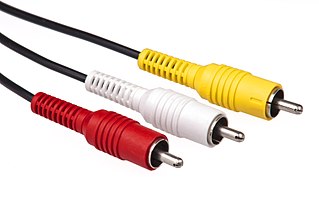 W
WThe RCA connector is a type of electrical connector commonly used to carry audio and video signals. The name RCA derives from the company Radio Corporation of America, which introduced the design in the 1930s. The connectors male plug and female jack are called RCA plug and RCA jack.
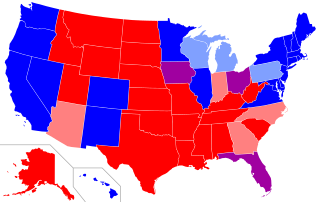 W
WSince around the 2000 United States presidential election, red states and blue states have referred to states of the United States whose voters predominantly choose either the Republican Party (red) or Democratic Party (blue) presidential and senatorial candidates. Since then, the use of the term has been expanded to differentiate between states being perceived as liberal and those perceived as conservative. Examining patterns within states reveals that the reversal of the two parties' geographic bases has happened at the state level, but it is more complicated locally, with urban-rural divides associated with many of the largest changes.
 W
WUtility location is the process of identifying and labeling public utility mains that are underground. These mains may include lines for telecommunication, electricity distribution, natural gas, cable television, fiber optics, traffic lights, street lights, storm drains, water mains, and wastewater pipes. In some locations, major oil and gas pipelines, national defense communication lines, mass transit, rail and road tunnels also compete for space underground.
 W
WIn October 2006, the United States Geological Survey (USGS) adopted a nationwide alert system for characterizing the level of unrest and eruptive activity at volcanoes. The system is now used by the Alaska Volcano Observatory, the California Volcano Observatory, the Cascades Volcano Observatory, the Hawaiian Volcano Observatory and the Yellowstone Volcano Observatory.